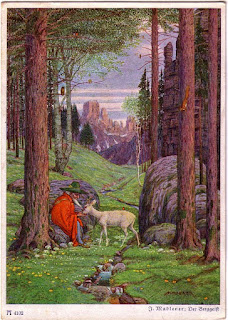Beowulf the warrior, a Geat from southern Sweden, travels to Denmark to the hall of King Hrothgar. Hrothgar has been menaced by a monster, Grendel, who comes at night and kills and eats Hrothgar's men. Beowulf lies in wait in the hall, and fights Grendel that night, ripping off Grendel's arm. Grendel flees back to the marshes.
That night, after feasting, Grendel's mother visits the hall and kills one of Hrothgar's men while they all lay asleep. The next day, Beowulf and Hrothgar and their men track the monster to a lake. One of Hrothgar's retainers who had been rude to Beowulf upon his arrival offers his sword to Beowulf. Beowulf tells Hrothgar that, if he does not return from under the lake, Hrothgar must accept Beowulf's followers as his retainers. He dives in, finding a cave at the bottom where he encounters Grendel's mother.
The sword he was given has no effect on her hide, but her attempts to stab him are likewise turned aside by his armor. Spotting a giant blade hanging on the wall, he grabs it and cuts off her head. He finds Grendel's body, cuts off Grendel's head with the giant sword, whose blade then melts away from Grendel's corrosive blood. He returns to the surface where his men are waiting, and presents Grendel's head and the hilt of the sword to Hrothgar. Hrothgar gives Beowulf gifts and a makes speech about avoiding pride.
Beowulf returns home, where he eventually becomes king of his people. Fifty years later, a dragon menaces the land because a thief stole a cup from its hoard. Beowulf fights it alone, deserted by his fearful men except for one man. Beowulf's body is burned in a great pyre.
It is an interesting mix of fictional, mythical, and historical elements. A number of characters mentioned in the poem show up in other records as historical figures, and one event mentioned is related by Gregory of Tours. One of the elements is the name of the hero. "Beowulf" is a kenning: a compound word using figurative language to represent a single noun. In this case, Beowulf means "bee wolf"; that is, one who preys on bees. This was one way to describe a bear.
Bears were symbolic of strength and power in Norse legend. The common name "Bjorn" means bear, and was clearly the origin of the were-bear character of Beorn in Tolkien's The Hobbit. There is a Norwegian legend of a king named Bjorn, whose wife was named Bera ("she-bear"). They had a child named "little bear"; I want to tell you about his legend next, and about his two brothers, who likewise had a connection to animals.







